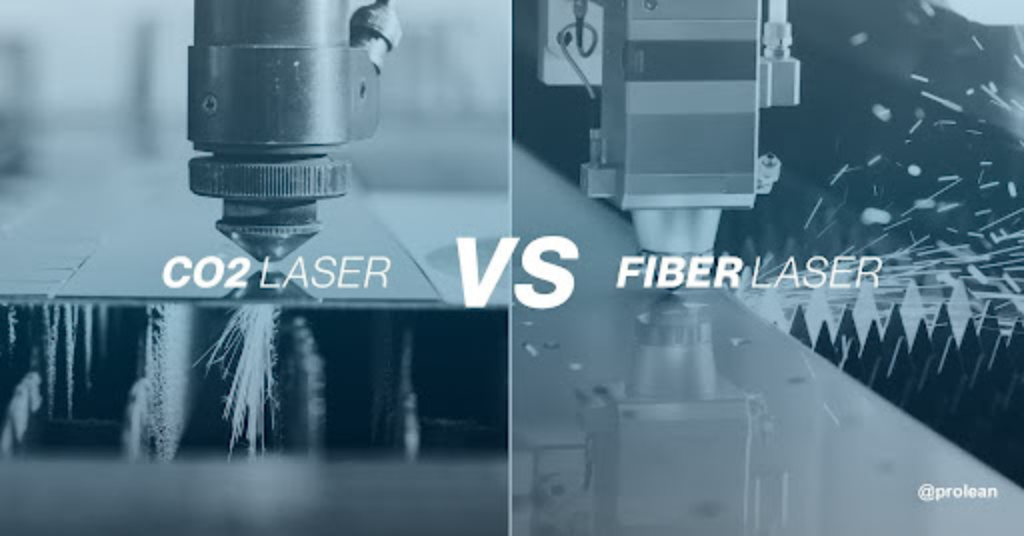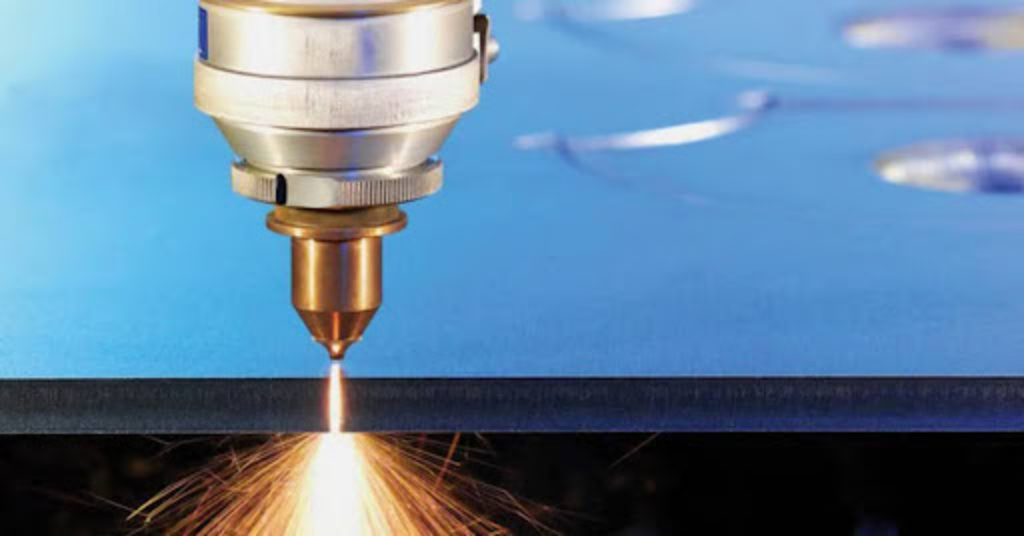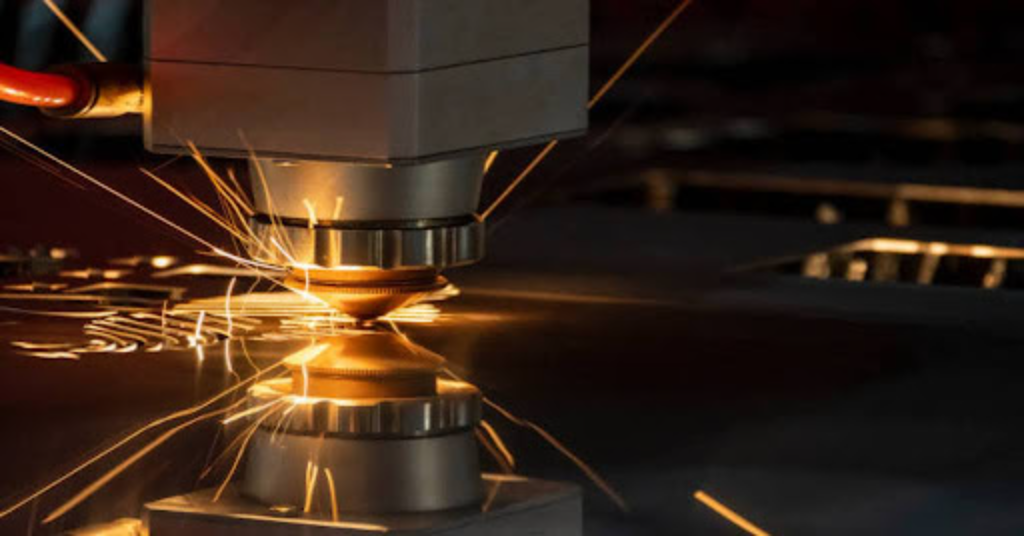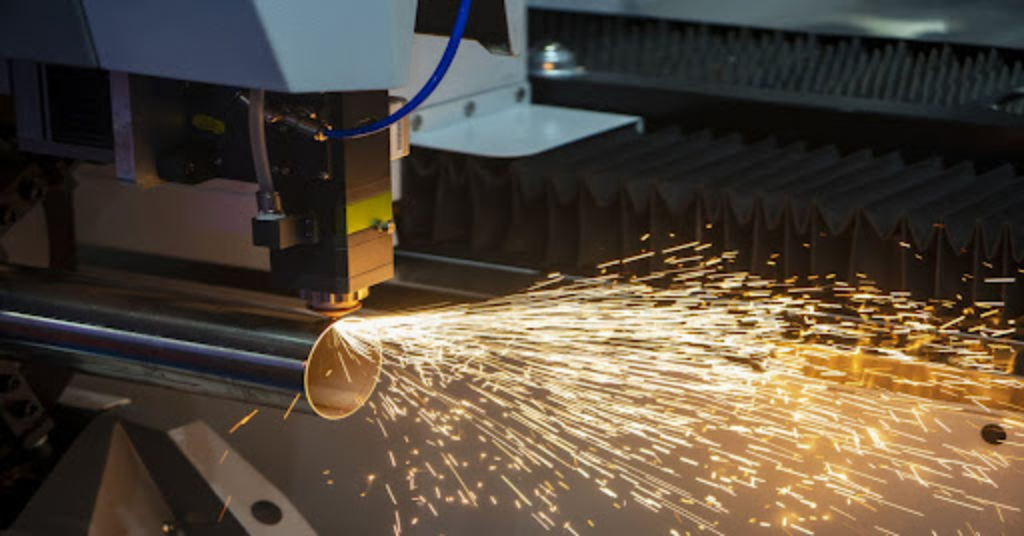“Laser cutters are abundantly used across metal and plastic working industries. They are becoming indispensable for cutting nearly all materials, from engineering plastics to high-strength metals. “

For laser cutting, you’ll find two types of lasers: CO₂ and fiber lasers. Each type has strengths and weaknesses that you must consider, considering your particular requirements. Fiber lasers are perfect for cutting a wide range of materials and are much faster than other types. They are most effective for thin sheets, i.e., 5 mm and below. Nevertheless, CO₂ lasers can more efficiently cut thicker materials (5-20 mm) than CNC plasma cutters.
Oxygen-assisted CO₂ lasers are mostly used for very thick materials like steel up to 100 mm. This blog aims to highlight the key distinctions between two types of laser cutters, CO₂ and fibre lasers, to know about when choosing services or buying equipment.
What is CO₂ Laser Cutting?

CO₂ Laser Cutting
The CO₂ laser operates by applying an electric field to a gas-filled tube, which causes the vibration of molecules in carbon dioxide. This tube includes nitrogen (N2), carbon dioxide (CO₂), helium, and a small amount of hydrogen and xenon. The electric field makes N2 molecules vibrate, and they release the energy to CO₂ molecules through sympathetic oscillation. This process heats helium atoms; thus, they emit photons and produce laser light. The CO₂ lasers have two primary frequencies of laser light, and their wide range of uses makes them popular in many applications because of their versatility and effectiveness. CO₂ lasers are notorious for emitting infrared radiation, which is very effective due to their low-frequency electromagnetic waves. These lasers offer several advantages:
- Simple Construction: However, CO₂ lasers’ complex physics are the simple ones to build.
- Wide Power Range: They can be adjusted to get power outputs from milliwatts to high kilowatts.
- Cost-Effective: CO₂ lasers are cheaper to produce than other types available in the market.
- Continuous Beam: Such systems offer a constant beam with peak power output power at all times.
- Scalability: A boost in power can be accomplished by using a longer tube.
- Q-Tuning Capability: By adjusting mirror components, CO₂ lasers can be Q-switched, enabling high pulse power.
In addition, recent developments such as RF gas flow CO₂ slab lasers have greatly improved output, product life, and overall efficiency.
Try Prolean Now!
What is Fiber Laser Cutting?
A fiber laser is a laser that is constructed using a fiber optic cable as its core. Light is injected into the fiber employing a small laser diode that acts as the pump source. Optical fiber contains dopants that are used to boost the light. The laser operates through a series of steps: the pump source produces light, and the fibre optic guide, which is clad, captures the light, keeping most of it. The light goes into the laser cavity, interacting with rare-earth dopants, producing more light through electron excitation and relaxation. This procedure is responsible for the frequency of the laser light that will be emitted.

Fiber laser cutting
The ytterbium dopant, a 1064 nm emitter, is the most common in laser cutting applications. The light generated inside the laser cavity is reflected by fiber-Bragg gratings acting as internal reflectors, keeping the light in the cavity. The other type of fiber bragg grating is an optical gate that lets some light pass and reflects most of it in the cavity. The laser light then leaves the cavity through a fiber guide, which is highly collimated (i. e., it is almost the end of the journey (very parallel) by this stage. The beam is then focused through a lens, which produces the required shape and diameter for the cutting procedure.
Fiber lasers, as a specialized category of solid-state lasers, offer several key advantages compared to other types of cutting techniques.
- Maintenance-free functions over extended periods, which in turn reduce downtime and maintenance costs.
- Flexibility through the ease of integration into different equipment and systems, increasing versatility and adaptability.
- Consistent and unwavering reliability and stability during operation, guaranteeing high performance.
- High-quality beams with less noise and minimal flicker in low frequency, suitable for high-precision applications.
- Compact and portable designs of fiber lasers enable product manufacturers to transport cutters easily and save space.
- Compared to the same capacity power systems, the low upfront cost offers a cost-effective solution.
- They can withstand or endure various weather conditions, including temperature variations, making them ideal choices for different environments.
What Common Materials Can Each Type Cut?

Stainless Steel Pipe Laser Cutting
CO₂ lasers are notably considered the best cutting equipment or utensils for nonmetallic and nonferrous materials, including acrylic, paper, wood, leather, plastics, and ceramics. On the other hand, fiber lasers are more versatile and can also cut through many exotic materials, including metals, glass, acrylic, and thick cards. Fiber lasers have a very high cutting productivity for metals up to 20 mm thick and can also be used for materials such as acrylic and paper.
Difference Between Fiber Laser & CO₂ Laser
CO₂ lasers, conversely, require higher power to cut the same-dimension product or part than fiber lasers, which could then tend to incur higher operational costs on the product development budget.
Which One Is Safer to Use? CO₂ or Laser Fiber? CO₂ and fiber lasers pose the same safety risks, as their power densities are similar. They can also emit harmful stray light. Nevertheless, CO₂ lasers are usually larger and more hazardous than fiber lasers of equal power. Therefore, CO₂ laser generators must be designed for high-risk applications.
Subsequently, CO₂ lasers are more adaptable and affordable regarding the initial investment cost than fiber lasers. Fiber lasers further possess high precision in cutting compared to CO₂ lasers. They also have a much longer working life span, approximately 25,000 working hours, which is 10 times longer than standard CO₂ lasers. Furthermore, the advantage of refurbishing services for fiber lasers makes them indispensable and relatively impactful over CO₂ laser tools.
Power Differences Between Each Laser Cutting Type
The CO₂ lasers come in multiple power rangers, ranging from a few watts to 100 kW. In the case of CO₂ lasers, the longer the laser, the lower the quality of the beam if the power is high. Moreover, they are not very effective and entail less capacity of about 5-10%. This cause leads to using coolant requirements during operations till part formation.
Compared to fiber lasers, the power range of low-power ytterbium-doped fibers is similar to that of CO₂ lasers but can reach up to 1 MW for larger, more expensive units. These fiber lasers are very efficient and can achieve efficiencies of up to 90% and this, in turn, reduces the need for cooling, even in small devices.
Try Prolean Now!
The Optimal Wavelength Difference Between Each Type
The wavelength of a CO₂ laser is about ten times longer than that of a fiber laser. CO₂ lasers emit light about 10.6 µm or 9 µm). In addition, different types of fiber lasers produce light at various wavelengths, around 532 nm for green lasers and 1064 nm for ytterbium-doped fiber lasers.
Fiber Vs. CO₂ Laser Cutting: Which Is More Expensive?
Regarding capital cost, fiber lasers have a higher initial investment per watt than CO₂ lasers. But fiber lasers, for their longer functional life and performance, often turn out to be a more economical solution in the long run.
Furthermore, fiber lasers deploy a much higher operational efficiency, usually more than 90%, while CO₂ lasers can only reach an efficiency of up to 5-10%. In these cases, fiber lasers are preferred and considered efficient in terms of lower operational power costs.
Which Industry Uses CO₂ Commonly?
CO₂ lasers provide versatility in cutting a wide range of materials, so their application area is wide for manufacturing critical interior components used across multiple manufacturing industries. Some common areas include medicine, military, communication, and manufacturing. CO₂ lasers, in addition, are superior in cutting even thicker materials, usually up to 10 to 20 mm. Operators may sometimes apply oxygen assistance to speed up the cutting process, particularly for thicker materials about 100 mm in steel laser cutting processes.
What Is The Cutting Range of a Laser Cutter?
The fiber machines can pierce a laser cutting sheet metal of about 13mm. In contrast, powerful ones may cut soft materials like aluminum at a thickness of up to 30mm, but often pose higher prices on part manufacturing. Unlike CO₂ lasers, which can control or lower their cutting range, UV lasers can cut through several workpieces of different thicknesses because of their longer wavelength. Additionally, What is the Usual Cutting Speed For Each Type? Fiber laser machines can cut at approximately twice or thrice the speed of similarly sized CO₂ machines, though this also largely depends on the laser cut material.
Which Industry Heavily Uses Fiber Lasers For Part Cutting?
Fiber lasers are generally employed in high-precision demanding industries like telecommunications, medical, material processing, automotive, and electronics. They are proficient in shearing metals, especially those that are nearly hard to cut and reflective, such as laser cutting titanium, brass, and aluminum.
Try Prolean Now!
Key Takeaways:
However, there are no defining parameters for choosing. The optimal technique is selected based on application, material type, and other considerations. This article gives a general idea of CO₂ and fiber laser cutters, highlighting their functions, outstanding features, and the materials each laser cutter is best for. If you need additional details on laser cutters, you can contact prolean. Our company offers comprehensive laser cutting services for cutting numerous materials. You can request a free, no-obligation quote from our engineers by clicking on our Contact Us page.




0 Comments